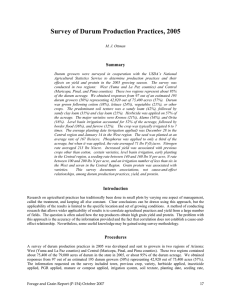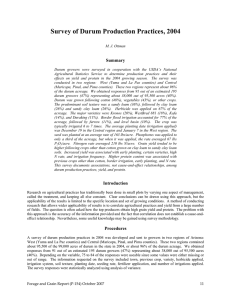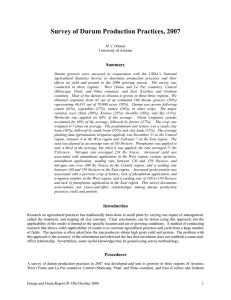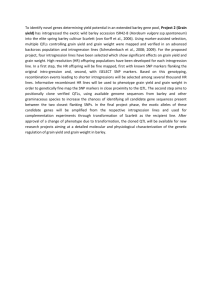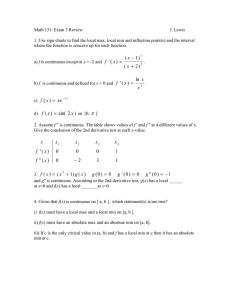Survey of Durum Production Practices, 2006 Abstract
advertisement
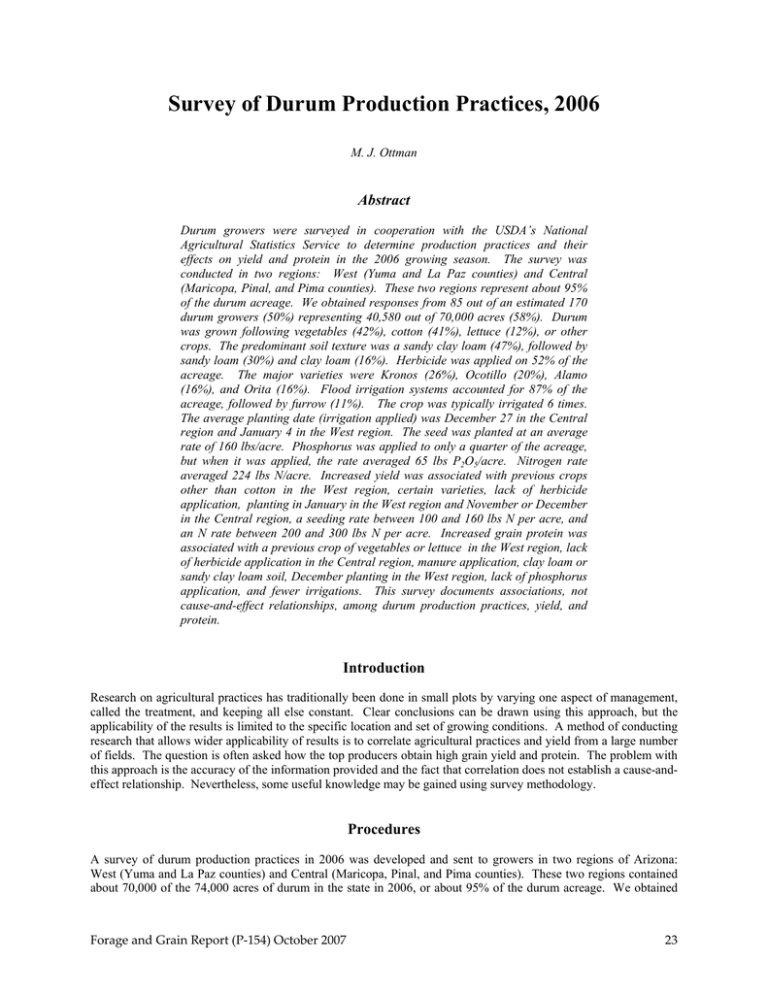
Survey of Durum Production Practices, 2006 M. J. Ottman Abstract Durum growers were surveyed in cooperation with the USDA’s National Agricultural Statistics Service to determine production practices and their effects on yield and protein in the 2006 growing season. The survey was conducted in two regions: West (Yuma and La Paz counties) and Central (Maricopa, Pinal, and Pima counties). These two regions represent about 95% of the durum acreage. We obtained responses from 85 out of an estimated 170 durum growers (50%) representing 40,580 out of 70,000 acres (58%). Durum was grown following vegetables (42%), cotton (41%), lettuce (12%), or other crops. The predominant soil texture was a sandy clay loam (47%), followed by sandy loam (30%) and clay loam (16%). Herbicide was applied on 52% of the acreage. The major varieties were Kronos (26%), Ocotillo (20%), Alamo (16%), and Orita (16%). Flood irrigation systems accounted for 87% of the acreage, followed by furrow (11%). The crop was typically irrigated 6 times. The average planting date (irrigation applied) was December 27 in the Central region and January 4 in the West region. The seed was planted at an average rate of 160 lbs/acre. Phosphorus was applied to only a quarter of the acreage, but when it was applied, the rate averaged 65 lbs P2O5/acre. Nitrogen rate averaged 224 lbs N/acre. Increased yield was associated with previous crops other than cotton in the West region, certain varieties, lack of herbicide application, planting in January in the West region and November or December in the Central region, a seeding rate between 100 and 160 lbs N per acre, and an N rate between 200 and 300 lbs N per acre. Increased grain protein was associated with a previous crop of vegetables or lettuce in the West region, lack of herbicide application in the Central region, manure application, clay loam or sandy clay loam soil, December planting in the West region, lack of phosphorus application, and fewer irrigations. This survey documents associations, not cause-and-effect relationships, among durum production practices, yield, and protein. Introduction Research on agricultural practices has traditionally been done in small plots by varying one aspect of management, called the treatment, and keeping all else constant. Clear conclusions can be drawn using this approach, but the applicability of the results is limited to the specific location and set of growing conditions. A method of conducting research that allows wider applicability of results is to correlate agricultural practices and yield from a large number of fields. The question is often asked how the top producers obtain high grain yield and protein. The problem with this approach is the accuracy of the information provided and the fact that correlation does not establish a cause-andeffect relationship. Nevertheless, some useful knowledge may be gained using survey methodology. Procedures A survey of durum production practices in 2006 was developed and sent to growers in two regions of Arizona: West (Yuma and La Paz counties) and Central (Maricopa, Pinal, and Pima counties). These two regions contained about 70,000 of the 74,000 acres of durum in the state in 2006, or about 95% of the durum acreage. We obtained Forage and Grain Report (P-154) October 2007 23 responses from 85 out of an estimated 170 durum growers (50%) representing 40,580 out of 70,000 acres (58%). The information requested on the survey included town, previous crop, variety, herbicide applied, insecticide applied, PGR applied, manure or compost applied, irrigation system, soil texture, planting date, seeding rate, fertilizer application, and number of irrigations applied. The survey responses were statistically analyzed using analysis of variance. Results and Discussion Durum acreage in 2006 was roughly split between the West (56%) and Central (44%) regions, and grain yield was higher in the West region (Table 1). The county with the greatest percentage of the acreage was Yuma (50%) followed by Pinal (23%) and Maricopa (17%). Grain yield was highest in Yuma and Pinal Counties, and grain protein was not different among counties. Durum was most often planted after vegetables (42%), cotton (41%) or lettuce (12%). The highest yields and protein in the West region were obtained after vegetables or lettuce. The top four varieties in terms of percentage of acreage were Kronos (26%), Ocotillo (20%), Alamo (16%), and Orita (16%). Several varieties were grown in both regions, but some such as Alamo were predominantly grown in the West region and others such as Ocotillo were predominantly grown in the Central region. Of the top 4 varieties mentioned above, both yield and protein were highest in Alamo in the West and Kronos in the Central region. However, there were other varieties that were not grown as widely that had either higher yield or protein. Herbicide was applied to most of the acreage in the West region, whereas most of the acreage in the Central region did not receive a herbicide application. Grain yield and protein (in the Central region) was slightly higher in the when herbicide was not applied. Insecticide was only applied to 1% of the acreage. Plant growth regulator (PGR) to control lodging was applied to less than 1% of the acreage. Manure or compost was applied to 14% of the acreage overall, and was associated with higher protein in the West region. The predominant irrigation system is border flood (73%) followed by level basin (14%) and furrow (11%). Grain protein was higher in the border compared to level basin system. I believe there may be some confusion among the respondents about the definition of border flood and level basin irrigation, so these results may not be representative. Durum was grown predominantly on sandy clay loam soil (47%) followed by sandy loam (30%) and clay loam (16%) soil. Grain protein was lower on sandy loam soil compared with clay loam and sandy clay loam. The average planting date was January 4 in the West region and December 27 in the Central region. The highest yields were obtained with a January planting date in the West region and November or December planting date in the Central region. Higher grain protein was obtained with earlier planting dates in the West region. The average seeding rate was 160 lbs seed/acre. Highest yields were reported for seeding rates between 100 and 159 lbs seed per acre. The average nitrogen rate was 224 lbs N/acre. The highest grain yield was associated with nitrogen rates between 200 – 299 lbs N/acre. The response of the durum crop to nitrogen fertilizer depends on several factors that were not included in this survey, such as initial soil nitrogen content. Only about a quarter of the durum acreage received P fertilizer, but a higher percentage of the acreage in the Central region received P fertilizer than in the West region presumably due to adequate soil P in the West from vegetable production. When P fertilizer was applied, the average phosphorus rate was 65 lbs P2O5/acre. Application of P fertilizer in the Central region was associated with lower grain protein, but again, response to P fertilizer is also influenced by other factors, such as soil P. The average number of irrigations applied was 6.2. The number of irrigations applied was not associated with yield, but there was a weak trend for higher protein with fewer irrigations in the West. Forage and Grain Report (P-154) October 2007 24 This survey has shown that there are some associations between the various durum production practices and grain yield and protein, but these associations do not imply a cause-and-effect relationship. Side by side comparisons are the best way to evaluate the direct effect of varieties, fertilizer rates, or irrigation practices. Nevertheless, increased yield was associated with previous crops other than cotton in the West region, certain varieties, lack of herbicide application, planting in January in the West region and November or December in the Central region, a seeding rate between 100 and 160 lbs N per acre, and an N rate between 200 and 300 lbs N per acre. Increased grain protein was associated with a previous crop of vegetables or lettuce in the West region, lack or herbicide application in the Central region, manure application, clay loam or sandy clay loam soil, December planting in the West region, lack of phosphorus application, and fewer irrigations. Acknowledgements I wish to thank the staff at the National Agricultural Statistics Service for designing and conducting the survey and collating the results. I also wish to thank Larry Aleamoni, Head of the Special Education Department at the University of Arizona, for his helpful suggestions on how to analyze the data. This project was funded by the Arizona Grain Research and Promotion Council. Forage and Grain Report (P-154) October 2007 25 Table 1. Number of survey respondents (N), grain yield, grain protein, and percentage of acres represented by various durum production practices in Arizona. West (Yuma and La Paz Co.) N Yield Protein Acres lbs/a % % Region West Central Significance County Yuma Pinal Maricopa La Paz Pima Significance Previous crop Vegetables Cotton Lettuce Durum Chile Sorghum Alfalfa Corn Significance Variety Kronos Ocotillo Alamo Orita WPB881 Kofa Sky Duraking Crown Havasu Matt Reva RoyalII BR0202W Significance Central (Maricopa, Pinal, and Pima Co.) N Yield Protein Acres lbs/a % % N All (West and Central) Yield Protein Acres lbs/a % % 38 . 6392 . --- 13.4 . --- 56 . . 47 . 5898 --- . 13.3 --- . 44 38 47 6392 5898 * 13.4 13.3 NS 56 44 33 . . 5 . 6506 . . 5640 . * 13.4 . . 13.5 . NS 50 . . 6 . . 25 15 . 7 . 6197 5507 . 5666 + . 13.5 13.2 . 12.8 NS . 23 17 . 4 33 25 15 5 7 6506 6197 5507 5640 5666 ** 13.4 13.5 13.2 13.5 12.8 NS 50 23 17 6 4 20 5 12 . . . . 1 6434 5940 6627 . . . . 5000 + 13.4 12.9 13.5 . . . . 14.5 + 38 6 12 . . . . 0 1 40 . 3 1 1 1 . 5180 5983 . 4400 8000 4500 7000 . ** 12.5 13.3 . 14 13 12.3 13 . NS 4 35 . 4 1 1 0 . 21 45 12 3 1 1 1 1 6375 5978 6627 4400 8000 4500 7000 5000 ** 13.3 13.2 13.5 14 13 12.3 13 14.5 NS 42 41 12 4 1 1 0 0 9 . 8 5 4 4 . 3 . 1 . 1 1 1 6194 . 6769 6460 5874 6225 . 7033 . 6400 . 8600 5000 4220 * 13.2 . 13.6 12.9 13.4 13.8 . 13.3 . 13.4 . . 14.5 13.7 ** 16 0 16 7 7 4 1 2 0 1 0 1 0 0 9 17 . 6 1 . 6 . 4 . 1 . . . 6912 5866 . 5497 4500 . 5877 . 5100 . 6000 . . . ** 13.4 13.4 . 13.3 12.3 . 12.8 . 13.7 . . . . . + 10 20 0 9 1 0 2 0 2 0 1 0 0 0 18 17 8 11 5 4 6 3 4 1 1 1 1 1 6553 5866 6769 5935 5599 6225 5877 7033 5100 6400 6000 8600 5000 4220 + 13.3 13.4 13.6 13.1 13.2 13.8 12.8 13.3 13.7 13.4 . . 14.5 13.7 ** 26 20 16 16 8 4 3 2 2 1 1 1 0 0 Forage and Grain Report (P-154) October 2007 26 Table 1 (Con’d). Number of survey respondents, grain yield, grain protein, and percentage of acres represented by various durum production practices in Arizona. West Central (Yuma and La Paz Co.) (Maricopa, Pinal, and Pima Co.) N Yield Protein Acres N Yield Protein Acres lbs/a % % lbs/a % % Herbicide applied No Yes Significance Insecticide applied No Yes Significance PGR applied No Yes Significance Manure or compost applied No Yes Significance Irrigation system Border Level basin Furrow Sprinkler Significance Soil texture Sandy clay loam Sandy loam Clay loam Sand Silt loam Silty clay loam Clay Significance N All (West and Central) Yield Protein Acres lbs/a % % 10 28 6572 6328 * 13.4 13.4 NS 10 45 39 8 6058 5115 * 13.4 12.7 + 38 7 49 36 6163 6059 * 13.4 13.2 NS 48 52 37 1 6430 5000 NS 13.4 14.5 NS 56 0 46 1 5910 5318 NS 13.3 12 + 43 1 83 2 6142 5159 + 13.3 13.3 ** 99 1 37 1 6451 4220 * 13.4 13.7 NS 56 0 47 . 5898 . --- 13.3 . --- 44 . 84 1 6141 4220 + 13.3 13.7 NS 100 0 35 3 6383 6501 NS 13.3 14 ** 52 4 34 13 5959 5738 NS 13.2 13.4 NS 35 10 69 16 6174 5881 NS 13.3 13.5 * 86 14 28 9 . 1 6276 6686 . 7002 NS 13.5 12.9 . 14 ** 42 12 . 2 29 4 14 . 5862 6377 5834 . NS 13.3 13.3 13.2 . * 31 2 11 . 57 13 14 1 6066 6591 5834 7002 NS 13.4 13 13.2 14 NS 73 14 11 2 16 13 7 . 1 6506 6534 6225 . 5000 13.5 13.2 13.3 . 14.5 34 12 9 . 0 13 25 6 1 1 5557 5895 6580 6000 6508 13.1 13.3 13.6 12.9 13.1 13 18 7 5 1 29 38 13 1 2 6080 6113 6389 6000 5754 13.3 13.3 13.4 12.9 13.8 47 30 16 5 1 . 1 . 5300 NS . 13 * . 0 1 . 5600 . NS 13 . + 1 . 1 1 5600 5300 NS 13 13 NS 1 0 Forage and Grain Report (P-154) October 2007 27 Table 1 (Con’d). Number of survey respondents, grain yield, grain protein, and percentage of acres represented by various durum production practices in Arizona. West Central (Yuma and La Paz Co.) (Maricopa, Pinal, and Pima Co.) N Yield Protein Acres N Yield Protein Acres lbs/a % % lbs/a % % Planting date November December January February Significance Seeding rate (lbs/a) 100-119 120-139 140-159 160-179 180-200 Significance Nitrogen rate (lbs N/a) 0-99 100-199 200-299 300-499 Significance Phosphorus applied No Yes Significance Number of irrigations <6 6 7 >7 Significance All N All (West and Central) Yield Protein Acres lbs/a % % 1 17 17 3 6400 6399 6526 5600 + 14 13.5 13.3 13.2 ** 2 12 40 2 3 28 10 3 6167 6154 5196 5206 + 13 13.3 13.2 12.8 NS 5 29 8 2 4 45 27 6 6225 6246 6033 5403 + 13.3 13.4 13.2 13 NS 7 41 48 3 2 10 8 12 6 8100 6458 6428 6210 6033 NS 14.5 13.3 13.3 13.3 13.5 NS 1 8 25 11 10 2 5 12 11 17 5659 6080 6165 5709 5805 + 12 13.3 13.4 13.5 13.1 NS 1 4 12 11 17 4 15 20 23 23 6880 6332 6270 5970 5865 ** 13.3 13.3 13.4 13.4 13.2 * 2 11 38 22 27 3 13 12 9 7200 6274 6716 5983 + 14.2 13.3 13.4 13.3 ** 2 16 21 17 6 10 23 8 5133 5264 6454 5663 ** 13.4 13.1 13.1 13.6 NS 4 14 20 6 9 23 35 17 5822 5835 6544 5832 + 13.7 13.2 13.2 13.5 NS 6 30 40 23 28 10 6272 6730 NS 13.5 13 ** 47 8 27 20 5755 6091 NS 13.3 13.2 + 28 16 55 30 6018 6304 NS 13.4 13.1 NS 76 24 13 13 7 5 6695 6465 6158 5744 NS 13.5 13.4 13.2 13.4 * 13 29 7 6 20 11 6 10 5606 5917 6548 6070 NS 13.2 13.5 13.4 12.9 NS 16 9 5 14 33 24 13 15 6035 6214 6338 5961 NS 13.4 13.5 13.3 13.1 NS 29 37 13 21 38 6392 13.4 56 47 5898 13.3 44 85 6119 13.3 100 Significance: Statistical significance or probability that differences observed are due to chance. NS = not significant at the 10% probability level, + = significant at the 10% probability level, * = significant at the 5% probability level, and ** = significant at the 1% probability level. Forage and Grain Report (P-154) October 2007 28
